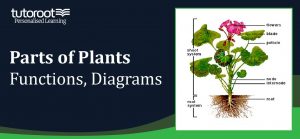Parts of Plants – Functions, Diagrams
On our planet earth, plants are essential for the survival of various life forms, as they produce oxygen, nutrients, food, etc. And not just that, they also offer various types of medicinal benefits and many more. And thus, it is important for the students to learn all about plants, their different parts, and their functions. Therefore, to help you out, we have put together a detailed description of Parts of Plants – Functions, Diagrams, etc.
What are Plants?
Plants are photosynthesis eukaryotes, that are categorized from the Kingdom Plantae. And these life forms include various parts, each performing multiple essential functions, and below we will list out the various parts of plants and their functions.

Parts of Plants
The different parts of the plants are,
- Roots
- Stems
- Leaves
- Fruits
- Flowers
Roots
The major part of all plants, as they combine together, form a root system, that helps the plants to stand firm in the soil so that they cannot be blown away by air, or other natural activities. In addition to this, they also play a major role in absorbing minerals as well as water from the soil. Moreover, the roots are differentiated into multiple types such as primary, secondary, and tertiary roots. While some of the roots, especially primary ones, have shorter life spans, while the secondary and tertiary roots have longer life spans. Besides this, there are certain plants that use roots to absorb oxygen, and this process is called respiration.
Stems
The components of the plants that are brown in color are generally located above the ground. The main function of the stems is to provide support for the plants, and also in the process of vegetative propagation. Other than this, this part of the plants also plays a role in other important processes such as the Transporation of water and food throughout the body, storage of food, Protective Layer, Reproduction, and many more. Furthermore, based on the surrounding vegetation, and the plant types, the stems also perform other important processes.
Leaves
As you already know, the leaves are the most important parts of the plant, mainly because they play an active role in Photosynthesis, Reproduction, and Transpiration. Furthermore, the leaves are composed of various components such as petiole, leaf base, and lamina, performing many functions like providing support, cooling the leaf, rigidity, etc.
Flowers
The most colorful parts of the plants are the flowers, which act as the reproductive part of the plants. And more importantly, it has multiple components like,
- Sepals – In order to protect the flower or bud from any damage, the green leafy parts under the flowers are essential.
- Petals – The role of these colorful parts of the flowers is to attract insects and birds.
- Pistil – This part of the plant acts as a female reproductive system, as it consists of various parts, like the ovary, stigma, and style.
- Stamens – Contrary to the pistil, this is the male reproductive system, which consists of parts such as Filament and Anther.
Fruits
The next colorful parts of the plants are fruits; however, they are not present in all types of plants. Mainly because these are observed as the resultant products of the fertilization process, which is not generally observed in all plants.
Conclusion
Now that you have got the answers to the question, what are the different parts of plants, the importance of plants, and stem plant If you have any more doubts on this subject, it would be a good choice to join Online Interactive Classes offered by various platforms. And if you are looking for a cost-effective Home Tutor Online program with multiple benefits, then Tutoroot might be a good choice for you.
Frequently Asked Questions
What is a plant?
The plant is a type of eukaryote, that uses the Photosynthesis process to produce energy and food.
